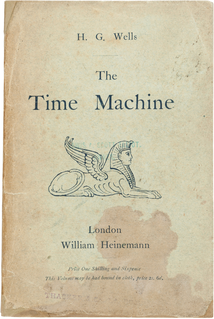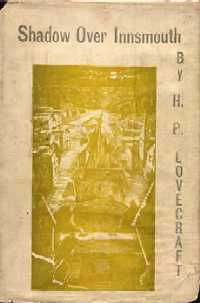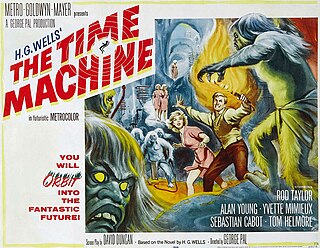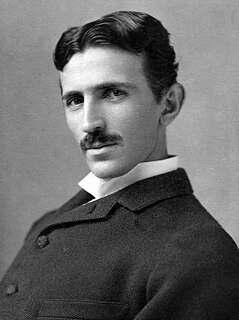
Thomas Alva Edison was an American inventor and businessman. He developed many devices in fields such as electric power generation, mass communication, sound recording, and motion pictures. These inventions, which include the phonograph, the motion picture camera, and early versions of the electric light bulb, have had a widespread impact on the modern industrialized world. He was one of the first inventors to apply the principles of organized science and teamwork to the process of invention, working with many researchers and employees. He established the first industrial research laboratory.

The Time Machine is a science fiction novella by H. G. Wells, published in 1895. The work is generally credited with the popularization of the concept of time travel by using a vehicle or device to travel purposely and selectively forward or backward through time. The term "time machine", coined by Wells, is now almost universally used to refer to such a vehicle or device.

Time travel is the concept of movement between certain points in time, analogous to movement between different points in space by an object or a person, typically with the use of a hypothetical device known as a time machine. Time travel is a widely recognized concept in philosophy and fiction, particularly science fiction. The idea of a time machine was popularized by H. G. Wells' 1895 novel The Time Machine.

The Time Ships is a 1995 hard science fiction novel by Stephen Baxter. A canonical sequel to the 1895 novella The Time Machine by H. G. Wells, it was officially authorized by the Wells estate to mark the centenary of the original's publication. The Time Ships won critical acclaim. It won the John W. Campbell Memorial Award and the Philip K. Dick Award in 1996, as well as the British Science Fiction Association Award in 1995. It was also nominated for the Hugo, Clarke and Locus Awards in 1996.

A Connecticut Yankee in King Arthur's Court is an 1889 novel by American humorist and writer Mark Twain. The book was originally titled A Yankee in King Arthur's Court. Some early editions are titled A Yankee at the Court of King Arthur.

Morlocks are a fictional species created by H. G. Wells for his 1895 novel, The Time Machine, and are the main antagonists. Since their creation by H. G. Wells, the Morlocks have appeared in many other works such as sequels, films, television shows, and works by other authors, many of which have deviated from the original description.

The Coming Race is a novel by Edward Bulwer-Lytton, published anonymously in 1871. It has also been published as Vril, the Power of the Coming Race.

To Say Nothing of the Dog: or, How We Found the Bishop's Bird Stump at Last is a 1997 comic science fiction novel by Connie Willis. It used the same setting, including time-traveling historians, which Willis explored in Fire Watch (1982),Doomsday Book (1992), and Blackout/All Clear (2010).

The Shadow over Innsmouth is a horror novella by American author H. P. Lovecraft, written in November–December 1931. It forms part of the Cthulhu Mythos, using its motif of a malign undersea civilization, and references several shared elements of the Mythos, including place-names, mythical creatures, and invocations. The Shadow over Innsmouth is the only Lovecraft story that was published in book form during his lifetime.
"Edisonade" is a term, coined in 1993 by John Clute in his and Peter Nicholls' The Encyclopedia of Science Fiction, for fictional stories about a brilliant young inventor and his inventions, many of which would now be classified as science fiction. This subgenre started in the Victorian and Edwardian eras and had its apex of popularity during the late 19th and early 20th centuries. Other related terms for fiction of this type include scientific romances. The term is an eponym, named after famous inventor Thomas Edison, formed in the same way the term "Robinsonade" was formed from Robinson Crusoe.

The Time Traveler's Wife is the debut novel by American author Audrey Niffenegger, published in 2003. It is a love story about Henry, a man with a genetic disorder that causes him to time travel unpredictably, and about Clare, his wife, an artist who has to cope with his frequent absences. Niffenegger, who was frustrated with love when she began the novel, wrote the story as a metaphor for her failed relationships. The tale's central relationship came to Niffenegger suddenly and subsequently supplied the novel's title. The novel has been classified as both science fiction and romance.

The Time Machine is a 1960 American period science fiction film in Metrocolor from Metro-Goldwyn-Mayer. It was produced and directed by George Pal and stars Rod Taylor, Yvette Mimieux, and Alan Young. The film was based on the 1895 novella of the same name by H. G. Wells that was influential on the development of science fiction.

Enrique Lucio Eugenio Gaspar y Rimbau was a Spanish diplomat and writer, who wrote many plays (zarzuelas), and one of the first novels involving time travel with a time machine, El anacronópete.

Nikola Tesla is portrayed in many forms of popular culture. The Serbian-American engineer has particularly been depicted in science fiction, a genre which is well suited to address his inventions; while often exaggerated, the fictionalized variants build mostly upon his own alleged claims or ideas. A popular, growing fixation among science fiction, comic book, and speculative history storytellers is to portray Tesla as a member of a secret society, along with other luminaries of science. The impacts of the technologies invented by Nikola Tesla are a recurring theme in the steampunk genre of alternate technology science-fiction.

"Blank!" is a science fiction short story by American writer Isaac Asimov. It was commissioned by Larry Shaw, editor of Infinity Science Fiction, as being the least inspirational title on which to base a story. Harlan Ellison and Randall Garrett were also invited to submit stories based on the same title; Garrett wrote one with "Blank?" as the title while Ellison submitted "Blank." All three were published in the magazine in June 1957. Asimov's story was later reprinted in the 1975 collection Buy Jupiter and Other Stories.

H. G. Wells was a prolific writer of both fiction and non-fiction. His writing career spanned more than sixty years, and his early science fiction novels earned him the title of "The Father of Science Fiction".
"Fire Watch" is a science fiction novelette by American writer Connie Willis. The story, first published in Isaac Asimov's Science Fiction Magazine in February 1982, involves a time-traveling historian who goes back to the Blitz in London, to participate in the fire lookout at St. Paul's Cathedral.

The War of the Worlds is a science fiction novel by English author H. G. Wells, first serialised in 1897 by Pearson's Magazine in the UK and by Cosmopolitan magazine in the US. The novel's first appearance in hardcover was in 1898 from publisher William Heinemann of London. Written between 1895 and 1897, it is one of the earliest stories to detail a conflict between mankind and an extra-terrestrial race. The novel is the first-person narrative of both an unnamed protagonist in Surrey and of his younger brother in London as southern England is invaded by Martians. The novel is one of the most commented-on works in the science fiction canon.
The idea of a fourth dimension has been a factor in the evolution of modern art, but use of concepts relating to higher dimensions has been little discussed by academics in the literary world. From the late 19th century onwards, many writers began to make use of possibilities opened up by the exploration of such concepts as hypercube geometry. While many writers took the fourth dimension to be one of time, others preferred to think of it in spatial terms, and some associated the new mathematics with wider changes in modern culture.

"The Clock That Went Backward" is a fantasy short story by Edward Page Mitchell.
















